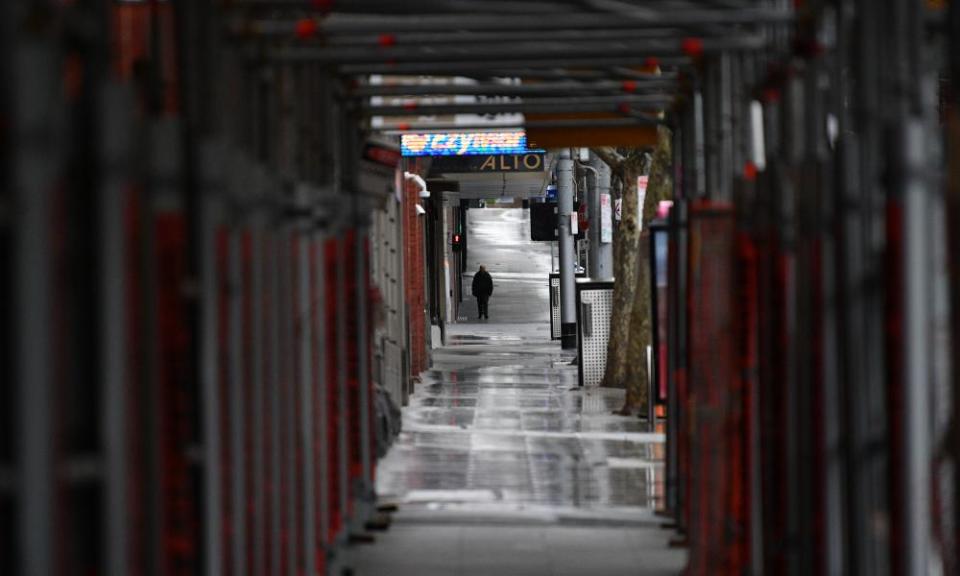More Australians feel negative about future compared to early stages of pandemic, survey suggests

Almost two-thirds of Australians believe life has worsened during the pandemic with more than half feeling negative about the future – a significant jump compared to during the first wave of infections in 2020, a new survey suggests.
The findings are contained in a biennial report on the wellbeing of the nation, published by the Australian Institute of Health and Welfare (AIHW) on Thursday.
Average life satisfaction fell substantially during the early stages of the pandemic, from 6.9 out of 10 in January 2020 to 6.5 in April 2020, the report states.
It rose in May 2020 to 6.8, as lockdowns eased. By January 2021, the average level of life satisfaction had returned to pre-pandemic levels. But by August, life satisfaction dropped to 6.5 again, as lockdowns were in force in some jurisdictions.
Related: One in four Australian teens report experiencing psychological distress in 2020
The AIHW report previously has found life satisfaction was stable in Australia.
The life satisfaction findings were informed by results from an Australian National University survey, called ANUPoll, which surveyed 3,135 people between 11 and 23 August this year. The survey coincided with 13 million people being in lockdown across the country.
Respondents in August 2021 were more likely to say that they felt negative about the future than they were in May 2020 (56.1% compared to 39.9%).
There was also a statistically significant increase in the proportion of people who felt more stressed compared to when the survey was conducted in 2020 (rising from 47% to 55.1%).
“When respondents were asked to reflect on their own lives, things seem to have worsened since May 2020,” the survey found.
“In May 2020 roughly half of the Australians thought their life had gotten worse (51.3%), including 6.5% who thought it had gotten much worse. By August 2021, almost two-thirds of Australians thought their life had gotten worse (65.7%) including 17% who thought it had gotten much worse.”
Co-author of the ANUPoll findings, Prof Nicholas Biddle, said the recent restrictions and lockdowns had resulted in people reporting worsening psychological distress and an increase in loneliness.
“NSW in general and Sydney in particular has experienced the worst of the change, but many other parts of the country have also been impacted,” Biddle said.
There was an increase in anxiety and worry for those who lived outside NSW which rose from 48.5% in April 2021 to 56% in August. NSW’s worries grew from 50.7% to 67.9% over the same period.
Fears about getting infected with Covid almost tripled nationwide, to 30.8% cent in August 2021.
There was also a large decline in confidence in state and territory governments, from 67.2% who expressed confidence in April 2021 to 62.1% in August. Meanwhile, 45.4% said they had “a great deal” or “quite a lot of” confidence in the federal government in April, which dropped to 40.6% by August.
“This is a significant decline … and well below the peak of 60.6% observed in May 2020,” the survey found.
The AIHW report also analysed projections from the Centre for Population and found future population growth was projected to slow over the next few years, falling from 1.3% last observed in 2019–20 to 0.1% in 2020–21 and 0.2% in 2021–22. This is the lowest level since 0% growth was recorded in 1916–17. The population is projected to reach 29.1m by mid-2032.
Australia has experienced, and is forecast to continue to experience, a net outflow of people – falling from an inflow of 195,200 people in 2019–20 to around -97,000 people by the end of 2020–21, and -77,000 people in 2021–22, before increasing to 235,000 people in 2024–25.
Australia’s total fertility rate has also been falling, from 1.87 babies per woman in 1989–90 to 1.65 in 2019–20. It was assumed to fall to 1.58 babies per woman in 2021–22 before increasing in later years and stabilising by 2030–31 at 1.62 babies per woman.
The report also examined house prices, which were briefly dampened by the 2020 recession. By the first quarter of 2021, however, prices were rising at the fastest quarterly rate since 2009 despite high unemployment, historically low wage growth, and population growth more than halving.
“Two in five households are in housing stress,” the report states. “One in three unemployed people are long-term unemployed. In April 2021, the long-term unemployed represented 33.5% of all unemployed people, a level not seen since the 1990s.”
Welfare spending grew by 12% to $195.7bn between 2018–19 and 2019–20 driven by economic measures the federal government introduced in response to the pandemic such as jobkeeper.
In the 12 months to June 2021, the number of income support recipients declined from 5.8m to 5.4m, reflecting the easing of restrictions. However, recipient numbers in June 2021 were still 7.4% higher than in March 2020.
Related: Overwork comes at a cost – in particular in a pandemic | Ahona Guha
The report concluded the house price boom would sharpen the wealth divide. It “was substantially a product of policy,” such as the federal government’s homebuyer and homebuilder grants, rather than purely the outcome of market forces, the report states.
“These appear to have placed Australia back on its pre-2020 housing market trajectory. This is a path that, through its effect in sharpening the wealth divide between property owners and renters, is a major contributor to the growing wealth inequality that itself poses a substantial policy challenge to both levels of government.”
• In Australia, support is available at Beyond Blue on 1300 22 4636, Lifeline on 13 11 14, and at MensLine on 1300 789 978. In the UK, the charity Mind is available on 0300 123 3393 and Childline on 0800 1111. In the US, Mental Health America is available on 800-273-8255

 Yahoo News
Yahoo News 